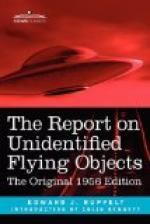For many months reporters and writers had been trying to reach behind the security wall and get the UFO story from the horse’s mouth, but no luck. Some of them were still trying but they were having no success because they were making the mistake of letting it slip that they didn’t believe that airline pilots, military pilots, scientists, and just all around solid citizens were having “hallucinations,” perpetrating “hoaxes,” or being deceived by the “misidentification of common objects.” The people of Project Grudge weren’t looking for this type of writer, they wanted a writer who would listen to them and write their story. As a public relations officer later told me, “We had a devil of a time. All of the writers who were after saucer stories had made their own investigations of sightings and we couldn’t convince them they were wrong.”
Before long, however, the right man came along. He was Sidney Shallet, a writer for The Saturday Evening Post. He seemed to have the prerequisites that were desired, so his visit to ATIC was cleared through the Pentagon. Harry Haberer, a crack Air Force public relations man, was assigned the job of seeing that Shallet got his story. I have heard many times, from both military personnel and civilians, that the Air Force told Shallet exactly what to say in his article—play down the UFO’s—don’t write anything that even hints that there might be something foreign in our skies. I don’t believe that this is the case. I think that he just wrote the UFO story as it was told to him, told to him by Project Grudge.
Shallet’s article, which appeared in two parts in the April 30 and May 7, 1949, issues of The Saturday Evening Post, is important in the history of the UFO and in understanding the UFO problem because it had considerable effect on public opinion. Many people had, with varying degrees of interest, been wondering about the UFO’s for over a year and a half. Very few had any definite opinions one way or the other. The feeling seemed to be that the Air Force is working on the problem and when they get the answer we’ll know. There had been a few brief, ambiguous press releases from the Air Force but these meant nothing. Consequently when Shallet’s article appeared in the Post it was widely read. It contained facts, and the facts had come from Air Force Intelligence. This was the Air Force officially reporting on UFO’s for the first time.




